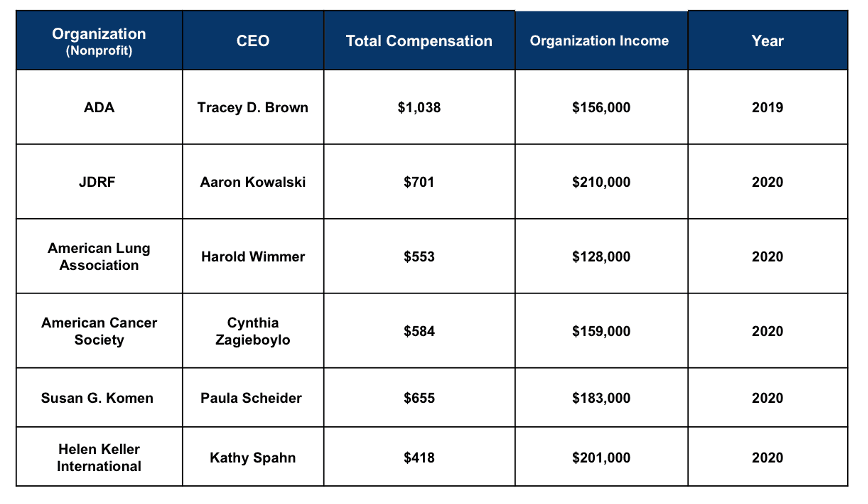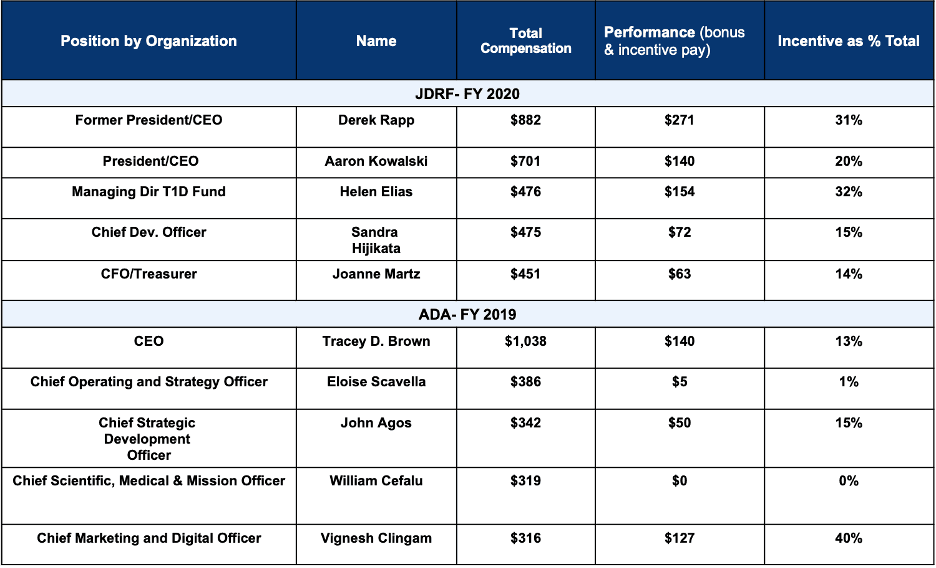This is the 10th annual review of executive pay at the major T1D non-profits – JDRF and the American Diabetes Association (ADA).
Diabetes executives are among the highest-paid in their field. According to each organization’s latest available financial documents, ADA CEO Tracey Brown made over $1 million in Fiscal Year (FY) 2019, while JDRF paid former CEO Derek Rapp $880K and current CEO Dr. Aaron Kowalski $700K in FY 2020. These executives are within the top 1% of earners in the United States and earn more than the top-level executives at similarly sized nonprofits.
Although their paychecks are large, the JDCA believes that competitive compensation packages are appropriate to attract and retain highly qualified leaders provided the executives deliver clear progress towards a T1D cure. The ADA and JDRF executives are in a rare position to direct substantial resources and manpower towards a T1D cure. The key question each reader should ask in terms of compensation is: “Did the executives lead their organizations to deliver enough progress toward a T1D cure that these high salaries are justified?”
Under the current pay structures, there is little public incentive for T1D executives to meet tangible cure goals. Neither the ADA nor JDRF publicly ties executive salaries to T1D cure progress, and only a small portion of compensation is based on performance of any kind. Further, there is currently no way for donors to influence the pay of executives. We believe that by evolving compensation models to focus on cure progress and providing donors with a ‘say on pay,’ T1D non-profits can accelerate a T1D cure.
Note: To conduct this report, the JDCA utilized publicly available IRS Form 990s and Consolidated Financial Statements. All information on JDRF is derived from Fiscal Year (FY) 2020 documents, which report on financial disclosures from July 1st, 2019- June 30th, 2020. The ADA has not yet published their Form 990 for FY 2020, so all data on the ADA in this report reflects FY 2019, which spanned from January 1st, 2019- December 31, 2019.
Summary Points:
- The majority of executive compensation at the ADA and JDRF is fixed and not tied to performance. See Appendix A.
- In FY 2020, 23% of JDRF executive compensation (top five highest-paid) was performance-based, up from 20% in FY 2019.
- In FY 2019, 13% of the ADA executive compensation (top five highest-paid) was performance-based, down from 17% in FY 2018.
- JDRF and the ADA’s CEO are compensated at a higher rate than other similarly sized non-profits. See Appendix B.
- The CEO of the ADA, Tracey D. Brown, made over $1 million in FY 2019, a year where the organization spent just 2% of its income on T1D-specific research (click) to read our report on the ADA’s FY 2019 financials).
- In our view, which we believe reflects the broader opinion of the T1D community, this remarkable compensation is not justified by the organization’s negligible impact on T1D cure progress.
- Donors do not have a direct way to influence executive compensation at the ADA or JDRF.
- According to JDRF’s 990, the organization “awards non-fixed payments such as bonuses on a discretionary basis tied to the employee’s performance.” It is unknown if these non-fixed payments are linked in any material way to progress towards a T1D cure, achieving donor priorities, or fulfilling research promises made in fundraising campaigns.
Performance-Based Pay Delivers Results
Top executives at the highest performing for-profit companies often have the majority of their annual compensation directly related to performance. The better the company does in achieving its objectives, the more the executives are compensated. Such compensation provides a powerful personal incentive to drive the company towards results that also benefit stakeholders and shareholders.
This model generally does not carry over to non-profit organizations. We believe this is a missed opportunity to drive urgency, focus, and overall performance towards achieving organizational goals.
How 'Say on Pay' Could Help Deliver a Practical Cure
JDRF and ADA compensation decisions are not made transparent to donors. A committee within the Board of Directors establishes a compensation strategy and provides annual approval for any performance-based pay and the average donor is given no input or transparency into the decision.
The JDCA recommends adopting a “say on pay” model to develop the relationship between executive compensation and donor interest. Corporations with “say on pay” provisions allow shareholders to vote on specific aspects of executive compensation, such as pay structure, base pay, and bonus amounts. “Say on pay” would make T1D nonprofit executives accountable to T1D donors in the way for-profit executives are accountable to shareholders.
Appendix A: Guaranteed Vs. Performance-Based Executive Compensation (Top Five Highest Paid, In Thousands)

Appendix B: Non-Profit Compensation Comparison (In Thousands)

Appendix C: Compensation of Top Five Executives (JDRF & ADA, In Thousands)

